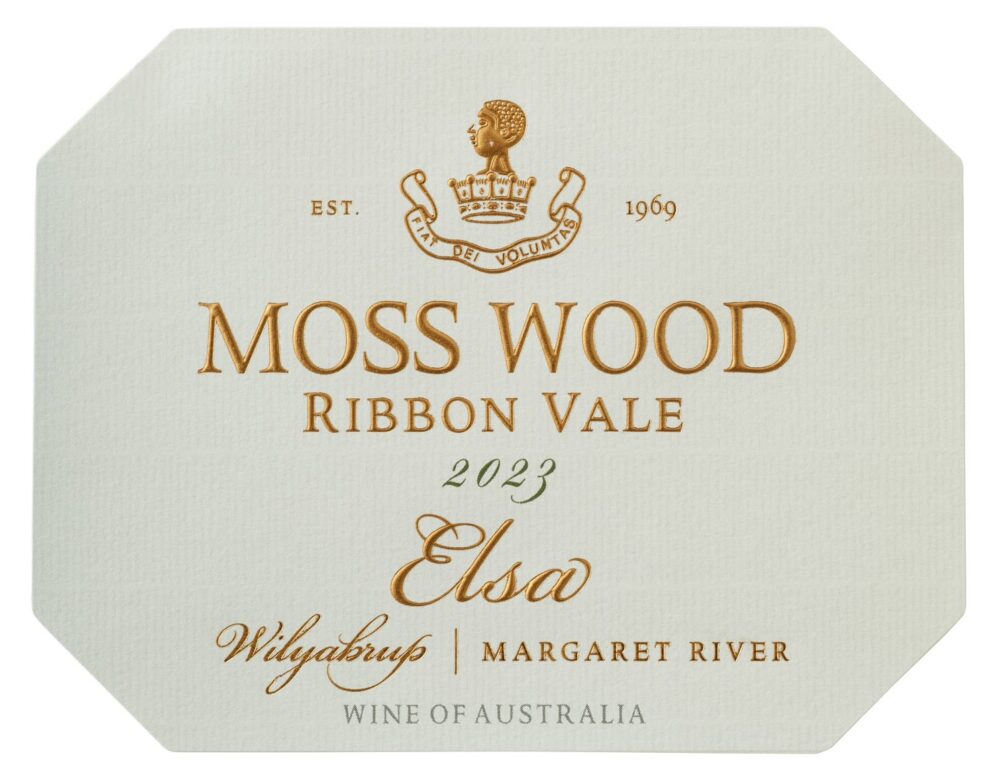Moss Wood Ribbon Vale 2023 Elsa

| Wine Facts | |
|---|---|
| Median Harvest Date | 14/03/2023 |
| Harvest Ripeness | 13.3 °Be |
| Yield | 10.8 t/ha |
| Day Elapsed between Flowering and Harvest | 102 days |
| Bottled | 18/01/2024 |
| Released | 08/03/2024 |
| Alcohol | 14.0% |
| Wine Facts | |
|---|---|
| Median Harvest Date | 14/03/2023 |
| Harvest Ripeness | 13.3 °Be |
| Yield | 10.8 t/ha |
| Day Elapsed between Flowering and Harvest | 102 days |
| Bottled | 18/01/2024 |
| Released | 08/03/2024 |
| Alcohol | 14.0% |
VINTAGE NOTES
2023 Ribbon Vale Vintage
The 2022-23 growing season was a very good one, potentially great! The vines enjoyed a solid winter of rainfall with 1114mm falling for the calendar year 2022, 9% above average. This level is optimal for our unirrigated vines as their deep root systems are able to access this soil moisture throughout the summer and avoid stress as the grapes begin to ripen.
We’re a bit fussy about when we want the rain to fall… lots through the winter, but once the vines begin flowering, we like the weather to turn mild and dry. Chardonnay, in particular, is extremely susceptible to inclement conditions which can result in below average yields. Readers can draw their own conclusions as to whether we’re asking for too much of mother nature. Fortunately, she looked after us in late 2022, with just 23mm falling during the Chardonnay flowering period and 8.6mm falling on the Sauvignon Blanc. All in all, conditions were fantastic and we were hopeful of solid crops.
We didn’t have it all our own way, however, as after the 9th of December, the tap pretty much turned off, with no rain recorded again until the 15th of March. Once again, if we’re being picky, we like to see some rain falling during December and January as these little top ups can help sustain the vines. Nevertheless, the drought wasn’t a problem and this became clear when we harvested. Both Chardonnay and Sauvignon Blanc produced good yields. Chardonnay came in at 5.72 tonnes/hectare, 19% above average, and Sauvignon Blanc registering 10.8 tonnes/hectare, 1% above average.
Temperatures were ideal, with Chardonnay recording an average growing season temperature of 19.96°C and Sauvignon Blanc 20.21°C. For context this puts 2022/23 as slightly cooler than 21/22 (21.01°C) and slightly warmer than 20/21 (19.43°C). These differences may seem small, but they’re responsible for perceivable stylistic variations in the wines.
Ultimately, the season unfolded smoothly, characterised by warm, rain-free days. The vineyard was free of disease and the fruit was in immaculate condition. Sauvignon Blanc was picked on the 14th March, about 2 weeks later than average, and Chardonnay coming off on the 24th March, 2 days later than average.
PRODUCTION NOTES
The inspiration for the Elsa production techniques continues to be the wines of the Loire Valley in France, specifically the localities of Sancerre and Pouilly-Fume. In both regions the emphasis is on complex Sauvignon Blanc and methods employed are similar to Burgundy. In its freshest form, Sauvignon Blanc produces ethereal, grassy wines typified by the Marlborough region in New Zealand. Although these wines have their place, our preference is for the more complex aromatics and texture and weight seen in the Loire.
The Sauvignon Blanc was picked by hand and transported to the winery, where the grapes were hand-sorted and pressed as whole bunches, followed by juice clarification and inoculation with multiple yeast strains for primary fermentation in stainless steel tanks. Alcoholic fermentation was maintained at a controlled temperature of up to 20°C. At the midway point, as activity slowed, the fermenting must was transferred to oak.
For the 2023 Ribbon Vale Elsa, barrels were 225-litre French oak barriques, with 7% being new. We aim for an integrated oak presence, harmoniously complementing both the aroma and palate.
Following full malolactic fermentation, each batch was blended, treated with sulfur dioxide, and returned to barrel. Oak aging continued until January 3rd, 2024, totaling 9 months, before the wine was blended in stainless steel. Although fining trials were conducted to optimise tannin balance, no treatments proved beneficial. Subsequently, the wine underwent bentonite fining for protein stability, cold stabilisation, sterile filtration, and was bottled on January 18th, 2024.
Tasting Notes
Colour and condition:
Clear and bright condition, pale straw colour.
Nose:
The nose is bright, lifted and displays characters of jasmine, ginger, loquats, lemon rind, lemon/lime curd and citrus cheesecake, hint of biscuit, honey and nougat in the background. Toasty and vanillan oak in the background.
Palate:
The palate has good weight and fruit depth with lingering flavours of white peach, nashi pear, honeydew melon and grapefruit. Generous mouthfeel and balanced acidity underpin rich characters of crème brulee and bread and butter pudding. There is some tannin on the finish giving the backbone required for good cellaring.
Cellaring:
The Elsa has the fruit depth and composition to age well and we recommend at least 10 years to ensure the development of a classic Sauvignon Blanc bottle bouquet of buttered toast and lanolin. In the meantime, the wine can be enjoyed for its attractive youthful freshness.

